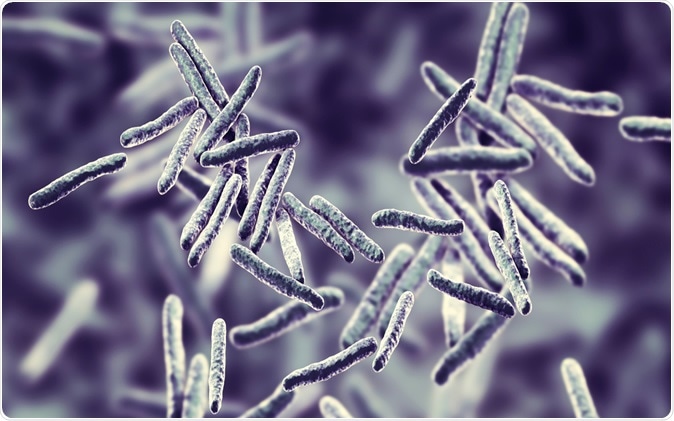
Bacteria Mycobacterium tuberculosis, the causative agent of tuberculosis, 3D illustration Credit: Kateryna Kon / Shutterstock
It is a matter of public record that research on tuberculosis in animal models seems to bring up different findings than those that actually happen when the same thing is applied to people with the disease. This is why drugs to treat and vaccines to prevent tuberculosis, and even diagnostic tests, just don’t work as well in human patients as they did in the experimental models. This is also the reason why the disease is still alive and rampaging in many parts of the developing world.
Researcher Shabaana A. Khader says, “For many years, scientists have been frustrated by the fact that animal models of TB — especially the genetically identical mice so often studied — don’t really reflect what we see in people with TB infections. This study is important because now we show in great detail where these animal models overlap with humans with TB and where they don’t.”
The study
The current study used mice with many different types of genes rather than the clones more often used in laboratory research. This ensures that the real-life experience of tuberculosis affecting a range of people with widely different levels of immunity can be recreated more efficiently and more faithfully. In other words, the mice show various ranges of severity, some with no symptoms at all, some with moderate and some with serious lung inflammation.
After recording the immune responses and the genetic data from this collection of infected mice, the researchers then went on to analyze the results from similarly infected macaques in San Antonio. Meanwhile, in South Africa, they were testing blood drawn from young people who were part of a clinical trial on tuberculosis. This means that the three sets of researchers were obtaining data from three different species, and these datasets could be studied, and the results compared with each other.
The results
The clinical trial in South Africa which has been going on for years has already picked up a cluster of 16 genes which are activated by tuberculosis infection more than a year in advance of clinical diagnosis. The pattern is so characteristic of active tuberculosis that it is called a human TB gene signature, and it marks the divide between patients with active tuberculosis and those with latent infection.
Of men and monkeys
Since macaques are close relatives of humans in some ways, they have been thought to share the same characteristics. The current study confirmed this, showing a complete overlap between the human TB gene signature and the genes activated in infected macaques. Says another researcher, Makedonka Mitreva, “It’s important to have the definitive data showing it to be true.”
Of mice and men
When the human signature was compared with that of infected mice, there was some overlap, but also enough of a discordance that in some areas, tuberculosis research in mice would not be very useful in advancing the treatment of human infection. Of the 16 genes that are overexpressed in people who go on to have severe tuberculosis infection, 12 are expressed in mice as well. The remaining 4 are either not present in mice or are essential for mouse development – when they are knocked out, the embryos die. These could not be studied, as a result, and we don’t know how they agree with the results in humans.
The 12 concordant genes are of three types: those which protect against the infection, those which increase the animal’s chances of being infected, and those which have no obvious effect.
The implications
The study is of immense importance. Khader explains: “Until now, we have studied mouse models to understand TB disease progression, not knowing where the mouse disease translates to human disease and where it doesn’t. Now, we have shown that many areas do translate but that there are important aspects of TB infection that don’t. If you are using mouse models to develop TB vaccines or other therapeutics that target areas that don’t overlap, you likely won’t succeed.”
As the result of this important new study, the immune pathways that are responsible for the disease processes have been identified. Now researchers will be able to choose animal models that will be helpful in working out one or more pathways of molecular or genetic response to the infection. They may also be able to choose the therapies that enhance the expression of the protective genes or inhibit those genes that increase susceptibility to tuberculosis.
The scientists say, “Together, our cross-species findings provide insights into modeling TB disease and the immunological basis of TB disease progression.”
The future
The researchers now plan to use the knowledge to analyze drug-resistant tuberculosis, which is a serious complication in endemic regions. The genetic signature will reveal which genes are being stimulated and which shut down in this scenario. Moreover, the data could also help reveal the reason behind the unexplained differences in induced immunity following tuberculosis vaccine administration to people at increased risk of infection – why some of them become immune while others remain susceptible. They have also put their observational data in the public domain for use by other tuberculosis researchers, in the best traditions of scientific inquiry and integrity.
Source:
Journal reference:
Mushtaq Ahmed, Shyamala Thirunavukkarasu, Bruce A. Rosa et al. Immune correlates of tuberculosis disease and risk translate across species. Science Translational Medicine. 29 Jan 2020: Vol. 12, Issue 528, eaay0233. DOI: 10.1126/scitranslmed.aay0233. https://stm.sciencemag.org/content/12/528/eaay0233